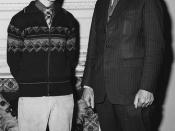The great depression marks a great divide in America's way of dealing with economics. The economical war between professional economists today is a never-ending battle. On one side there are those who believe in a classical idea that was born before the 1930's. Then the great depression influenced another army of economists that followed the ideas of a man named John Meynard Keynes. The reason this war is never ending is because it doesn't matter how hard an expert fights one side, there is another fighting on the other side. There have been endless debates as well as hundreds of thousands of pages written on both subjects. The point of this paper is to simply show some of the arguments for the Keynesian side of the argument. The classical Economists are those that believe in the ideas that spawned before the great depression. The Keynesian Economist believes in more of the ideas that were developed during and after the great depression.
Some things Classical economists believe in are Say's Law, steady employment, and self-adjusting markets. Demand driven economies, aggregate demand, short run, monopolies, and government-influenced economies are things the Keynesians believe in.
The first major difference between the Classics and Keynesians is they believe that economies are driven by two separate ideas. The Classics believe Say's law which is supply creates demand. In a perfect world, or in trading this is true. One good cannot be sold without the trade of another. Therefore the more being supplied, the more is being traded, or demanded. The Classical Economist never bothered to look at the demand side of things. For example: in a trading world, one fish is traded for one piece of firewood, or one piece of clothing. The economy is in equilibrium, and supply drives demand. However, as soon...


